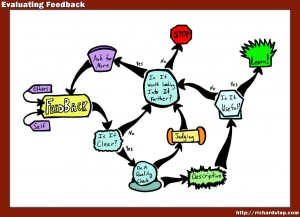I was never really big into the social media (socmed) stuff a few years back. Sure I played some online games, but that pales in comparison to how wide-spread socmed stuff is now. Hard to go through a day without getting the fix now, ya’ know?
But here’s the thing. I had a bit of trouble handling some of the trolls… ahem… critics that randomly pass by. They’ll blast me on a YouTube video and then never come back. Talk about rude! Sometimes I’d just get a random email that would mind-worm me until clear into afternoon!

To slay or not to slay depends on what they say or do not say!
All my fault. All my fault for not figuring out how to handle this stuff before I jumped into it. If you feel the same some days, then I’ve got a treat for you.
The Feedback Flowchart
Ready to take a look at this revolutionary tool that will transform the way you deal with positive, negative, or just plain useless feedback? Check it out:
This is a high level approach to quickly and easily evaluate all of the feedback coming your way. 5 steps at max and you’ll be good to go – living your day again. Trolls slain! Critics ignored! Happy you!
So let me run through the process here:
- You get feedback from others and yourself – don’t count yourself out – you talk a lot!
- Figure out whether that feedback is clear or not
- If it isn’t, then ram on over to figuring out if it’s worth looking at more
- If it is, then decide if it sounds like judgmental or descriptive language
- If it’s judging, then go to the “worth it” block
- If it’s descriptive, then decide if it’s useful or not
- If so, then LEARN FROM IT! :)
- If not, then go to the “worth it” block
Okay. That’s the gist of the positive feedback part of this flowchart. The next step, the “worth it” block, can be as complex or as simple as you’d like it to be. Having a bad day? Maybe nothing is really worth it at this point? Feeling frisky? Maybe everything is worth going after. You shift and decide as you see fit.
Let’s look at what happens when we’re at the “worth it” block.
- Ask yourself if this feedback is currently worth it or not
- If you think it is, then ask the feedback giver to clarify
- If you think it isn’t, then just stop. Thank them and push it into the air behind you. If they’re complete trolls (not friends), then don’t even worry about the thank you – drop and ignore it.
That’s it
Want to see Feedback Evaluation in Action?
Check out my most recent fictional encounter with my (surprisingly) fictional coworker, Bob.
Bob: Hey.
Me: Salutations my esteemed colleague!
Bob: What the… are you some type of dork?
Me: *dips into feedback flowchart mode*
***ANALYZING***
Feedback from other person taken as “am I a dork.” Running through the feedback steps:
- Is it clear? Quite
- What quality or type of feedback is it? Judging
- Is it worth pursuing further? Yeah – Bob’s normally an okay guy
- Ask Bob for clarification
***PENDING FURTHER INPUT***
Me: What exactly do you mean by ‘dork,’ Bob?
Bob: Oh nothing, Richard, I just haven’t had my coffee yet and am being a little funky.
***ANALYZING***
- Is his feedback clear? Yes – he didn’t mean it, though I might want to ask about his problem later
- What type of feedback is it now? We’ll call it descriptive at this point.
- Is it useful feedback? Not for my interpretation of his 4 letter blurb
- Is it worth pursuing? Nah – I’ll cut him some slack… THIS TIME!
- Stop thinking about this feedback
***ANALYSIS COMPLETE***
Me: No problem, Bob, we all have our days. Let’s go get some coffee!
And they all lived happily ever after to the next non-coffee related incident.
Use Positive or Negative Feedback to Grow
It’s taken me a bit of work to get to the point where I can just spot a critical troll, slay it, and then keep on moving. With great practice comes great power. With great power comes great… confidence!
Practice evaluating your feedback, both in your head and out. Don’t let others have so much control over you anymore. You make every decision – make them good ones.
***ANALYSIS COMPLETE***
